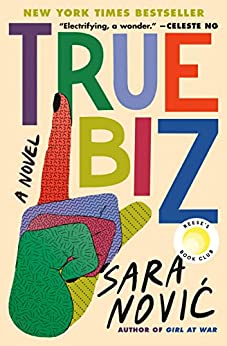True Biz: A Novel by Sara Noviç is an enlightening story about the deaf, particularly deaf children. The contemporary story takes place in Colson, Ohio at River Valley School for the Deaf (RVSD).
The title of the book, True Biz is an exclamation used in American Sign Language (ASL) that means really, seriously, definitely, or real talk. Students at RVSD simply want to understand the world around them, hang out with friends, and blend in. But, as with any special needs children, there are always obstacles to overcome.
The story centers around two children and the headmistress of the school.
Charlie, lives with her father as the result of a custody battle. Both her parents can hear, but Charlie was born deaf. When she was three years old she had surgery to install a cochlear implant, which, unfortunately didn’t work. Charlie suffers with annoying buzzing sounds and headaches. She attended public schools but became rebellious when she couldn’t understand what people were saying and had no way to communicate. When she was placed in RVSD she still couldn’t communicate because she had never learned ASL, which was how the students communicate with their teachers and one another.
Austin, also a student at RVSD is deaf like his parents and grandparents. He’s a well-adjusted, popular kid and is asked to show Charlie around the school, and the two form a special bond. Austin and his parents’ world become confusing when they have a new baby girl who can hear.
February is headmistress of River Valley School for the Deaf. She desperately fights to keep the school running despite its threatened closure, to meet her obligations at home, and try to fulfill the needs of her aging mother. She is a CODA, an acronym that stands for a hearing child of deaf adult(s).
True Biz is an unforgettable story. I learned a great deal about the deaf, their challenges and feelings of isolation. Author Sara Noviç, is deaf, so I had the assurance that she knows the loneliness and struggle for human connection. I learned about the debates surrounding deaf children: should they be equipped with a cochlear implant, learn to lip read, or learn ASL, choices that all have advantages and disadvantages. I learned that ASL is a language of concepts, that only as a last resort will a word be spelled out. Chapters are interspersed with interesting tidbits of deaf historical “cures,” remedies through the centuries, conventions to discuss deaf education, and diagrams of ASL.



This book looks like something I should read. Reminds me of what my late husband must have gone through during his school years. He was diagnosed a little too late with a nerve deafness when he was about 4 years old.. He eventually learned to read lips and thought about having a cochlear implant later in life, but his deafness was too severe. I married him when he wore one hearing aid, but as time went on, he had to wear two aids. One time he was unclogging a bathtub drain and he excitedly called me from the other room. I ran as fast as I could to see what had happened and he said, “Is this what water sounds like going down the drain?” Needless to say, we also had some real belly laughs over mistaken words, but I was never able to whisper sweet nothings in his ear. He always had to read my lips 🙂
Alice, what a touching story! Thank you for sharing, and thank you for the comment. I rode up an elevator with your husband one time at the end of a WWW conference–he had brought a load of stuff from the hotel room to your car. I hadn’t realized he had a hearing problem–at least it wasn’t obvious to me.
I read this book, too! And enjoyed it! Another great review!
We must have similar tastes in our reading material, Shanna. I really learned a lot about ASL–I’d always thought they spelled out every word. I did wonder how they could translate so fast! What a difficult problem the deaf must have, especially those who have never received proper training in ASL. Thank you for your comment.